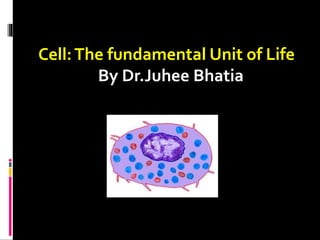
Cell the unit of life
- 1. Cell:The fundamental Unit of Life By Dr.Juhee Bhatia
- 2. Contents Discovery of Cell Prokaryotic and Eukaryotic Multicellular organisms Cell Membrane and Cell Wall Cell Organelles: Chloroplast, Mitochondria, Vacuoles, Endoplasmic Reticulum, Golgi Apparatus and Nucleus. Chromosomes ( Basic structure and Number)
- 3. Introduction of Cells Cell is a latin word for “little room”. Cell is the fundamental and structural unit of living organisms and basic unit of life. Cell biology: Study of cell in all respect of structure and function.
- 4. Discovery of cells 1. Robert Hooke-(1665) He observed dead cell which resembled honeycomb like structures in cork. He called these boxes cell. He published what he observed under microscope in his book Micrographia.
- 5. 2. Antony Von Leeuwenhoek-(1674) He as first to observe living cell in pond water (Algae-Spirogyra) 3. Robert Brown-(1831) He discovered nucleus. 4. J.E. Purkinjee-(1839) he used the term protoplasm. It is living matter present inside the cell. 5. Rudolf Virchow-(1855) German pathologists established that all cells arise from pre existing cells.
- 6. Cell Theory The cell Theory was formulated by two German biologists, M.J.Schleiden in 1838, German Botanist and T.Schwann, German physiologists in 1839. According to them, The cell is the functional and structural unit of all living beings. The cell theory was further expanded by Virchow.
- 7. Cell Theory stated that: Bodies of the living beings are made up of cells. Activities of an organisms are the sum total of activities of its cells. Cell develops from pre existing cells.
- 8. Size and shape of the cell Size of the cell: Normal size in human-20µm to 30µm in diameter Largest Cell: In animals- Ostrich eggs(15cm) In Plants- Acetabularia(6-10cm) Longest Cell: In animals- Nerve cell In Plants- hemp fibre Smallest Cell: PPLO- Pleuro Pneumoniae Like Organisms (Mycoplasma)
- 9. Shape of the cell
- 10. Unicellular vs Multicellular organisms The organism which are made of single cell are called unicellular organisms. Example bacteria, Amoeba, Paramecium, Chlamydomonas. The single cell is able to perform all life processes, like obtaining of food, respiration, excretion, growth and reproduction.
- 11. The organisms which are made up of number of cells are called Multicellular organisms. E.g. (except yeast), Plants and animals. All the cells of muticellular organisms have basic structure and under take similar basic functions.
- 12. Question?? Which property of multicellular organisms differentiate them from unicellular organisms? Due to the property of division of labour the cell in multicellular oragnisms are specialised to perform different functions of the body and in unicellular organisms only a single cell has to perform all activities.
- 13. Basic structure of cell Structure of cell Cell Membrane Protoplasm Cytoplasm Nucleus Mitochondria Nuclear membrane Choroplast Nucleoplasm Endoplasmic reticulum Nucleolus Golgi body Chromatin threads Lysosomes Centrosomes Vacuole
- 14. Plasma Membrane or Cell membrane All living cells, prokarytic and eukaryotic, have a plasma membrane that encloses their contents and serves as a semi-permeable or selectively permeable barrier to the outside environment. The plasma membrane is permeable o specific molecules, however, it allows nutrients and other essential elements to enter the cell and waste materials to leave the cells. Small molecules such as oxygen, carbon dioxide and water are able to pass freely across the membranebut the passage of larger molecules, such as amino acids and sugars, is carefully regulated. The plasma membrane is flexible and made up of organic molecu;les called lipids and proteins. Flexibility enables the cell to engulf in food and other materials (endocytosis). E.g. Amoeba.
- 16. Important points A living organisms is made up of one or more cells. Therefore, cell is structural and functional unit of life. All life functions of an organism reside in its cells. Cells may also become specialized to perform specific functions like contraction in muscle cell or impulse transmission in nerve cell. Therefore, cells are functional unit of life.
- 17. Transport across plasma membrane Substance may pass across the membrane with or without expenditure of energy. Transport Diffusion Osmosis Diffusion: The process of movement of substance (solid, liquid& Gas) from the region of its higher concerntration to the region of its lower concerntration so as to spread uniformly in the given space is called Diffusion.
- 18. *DiffusionAcross Cell Membrane* Metabolic gases (CO2 and O2) move out and into the cells through diffusion. Respiration of the cell produces carbon dioxide. As the concerntration of CO2 increases inside the cell into the external medium. Similarly concerntration of oxygen is always higher in the external medium as compared to the cell where it is being consumed in respiration. Therefore oxygen diffuses from outside to the inside of cell.
- 19. Osmosis: Osmosis can be defined as the diffusion of water or solvent across semi permeable membrane from a region of its higher concentration to the region of its lower concentration. Plasma membrane function as semi permeable membrane. Example of osmosis: Absorption of water by plant roots. Absorption of water by unicellular fresh water organisms. Types of osmosis- Osmosis is of two types: Endosmosis and exosmosis. Endosmosis is the osmotic entry of water into a cell or system. Exosmosis is the osmotic withdrawal of water from a cell or system.
- 20. Cell when placed in solution Plant and animal cells placed in salt or sugar solution will behave in one of the following ways depending upon the concentration of external solution. Hypotonic solution- The external solution is dilute as compared to cell contents. Is has more water content while the water content is lower inside the cell. The cell membrane allows passage of water in both direction. Due to difference in concentration of water moelcules, tere is net flow of water molecules into the cells. The phenomenon is called endosmosis.